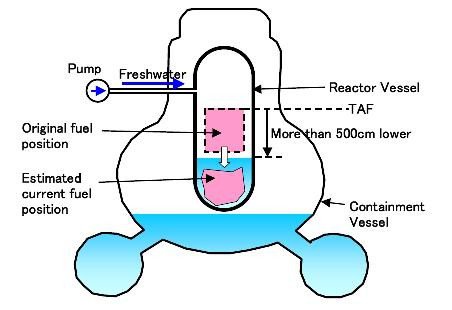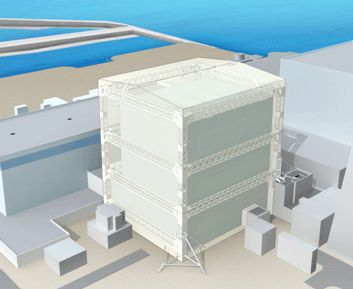Fukushima fuel melt confirmed
16 May 2011
Investigations at unit 1 at Fukushima Daiichi suggest that most of the fuel in the reactor core melted and dropped to the bottom of the reactor vessel in the early stages of the accident. Work has started on installing a structure to cover the damaged reactor building.
Tokyo Electric Power Company (Tepco) said that following the installation and calibration of two new water level gauges, water level readings suggest that most of the fuel in unit 1 had earlier melted and fallen to the bottom of the reactor vessel, where it has solidified and been kept adequately cooled. The company said that most of this core melt probably occurred within 16 hours after the unit automatically shutdown when the earthquake struck on 11 March.
 |
| Analyses suggest most of the fuel in unit 1 is now the bottom of the reactor vessel (Image: Tepco) |
The company said that readings showed the water level in the reactor vessel was "lower than five metres below the top of the active fuel (TAF), which means the water level was lower than the original bottom level of fuel." Tepco added, "It is estimated that the damaged fuel with control rods moved down to the lower plenum in the reactor and they are being cooled there stably." As a result of injecting water into the unit, the temperature of the reactor pressure vessel (RPV) has remained between 100 and 120°C.
Hamaoka halted
Chubu Electric announced that it has shut down units 4 and 5 of its Hamaoka nuclear power plant, as requested by the prime minister earlier this month.
Unit 4 - a 1092 MWe boiling water reactor (BWR) - was shut down on 13 May, while unit 5 - a 1212 MWe advanced boiling water reactor (ABWR) - shut down the following day. In addition, Chubu has agreed not to restart unit 3 - a 1056 MWe BWR. Hamaoka units 1 and 2 were permanently shut down after Chubu decided not to upgrade them to seismic standards brought in after a July 2007 quake. Unit 5 by contrast is one of the most modern reactors in the world, starting up only in 2005.
The utility is expected to be able to resume operation of the three units once tsunami defences at the plant have been strengthened.
|
In a statement Tepco said, "We would like to emphasize that due to the limitation of available data and information, the result of this analysis should be considered as provisional." It added, "We will continue efforts to have more accurate status of the reactor core through further investigation as well as for the units 2 and 3 through similar analysis."
The low water level raises the question of where the water injected to the reactor core over the last eight weeks has gone. Tepco said that it assumes that water is leaking from the RPV, but it does not suspect significant damage to the bottom of the RPV. It suspects that the molten fuel may have created holes in the RPV and damaged the containment vessel, allowing radioactive water to leak into the basement of the reactor building. The company is therefore reconsidering its plan to flood the containment vessel of unit 1, as this could potentially affect the overall plan to stabilise the site.
Tepco has increased the amount of water being injected into the reactor from eight tons per hour to ten tons per hour in order to see if this results in any change in the unit's parameters. The company will monitor the water level, temperature, and pressure inside the containment vessel for two days and will analyse the results to determine the best way forward to stabilise the reactor.
Keeping it covered
 |
| How the cover should look |
Tepco said that it started preparatory work today for the construction of a cover for unit 1, whose reactor building was severely damaged by a hydrogen explosion on 12 March. The cover is to be built as a temporary measure to prevent the release of radioactive substances from the unit until further measures, including radiation shielding, are implemented. Other such covers are planned at the other damaged Fukushima reactor buildings under Tepco's roadmap for the plant's restoration, announced in mid-April.
The company announced that it has started initial work on the project, including levelling the ground so that crawler cranes can be brought onto site for installing the cover. The installation of the cover for the reactor building will begin next month. Tepco said that the use of crawler cranes would minimize the exposure dose of workers and shorten the work period.
Death of worker
A sub-contractor working on the Fukushima Daiichi plant site has died, but his death is not thought to be a direct result of the nuclear accident there.
The worker had been working on the drainage system of the centralised radioactive waste store when he fell ill. He was taken to the on-site medical centre, where he lost consciousness and stopped breathing. Shortly after being transferred to a nearby hospital, the worker died. Tests showed that the worker had not been contaminated with radiation.
Researched and written
by World Nuclear News